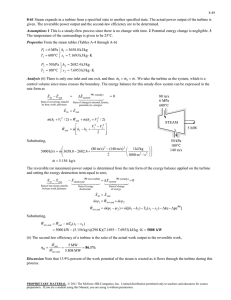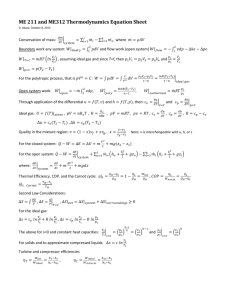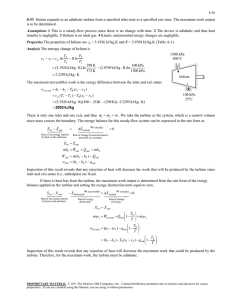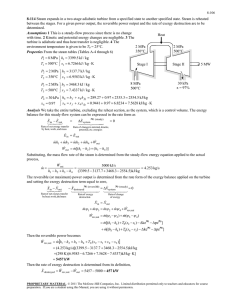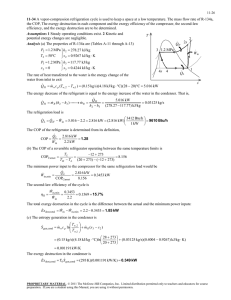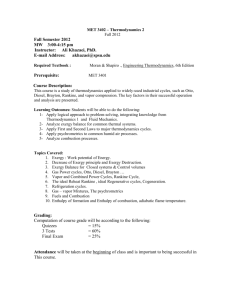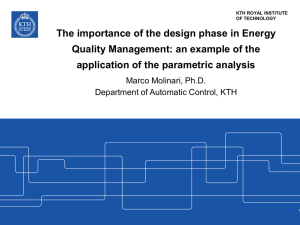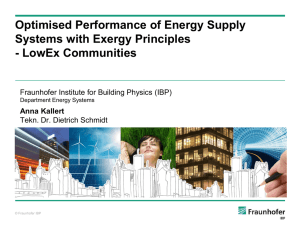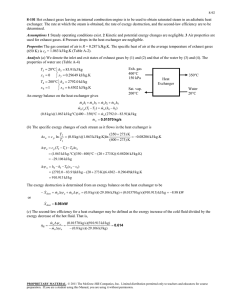Research Journal of Environmental and Earth Sciences 2(4): 239-244, 2010
advertisement
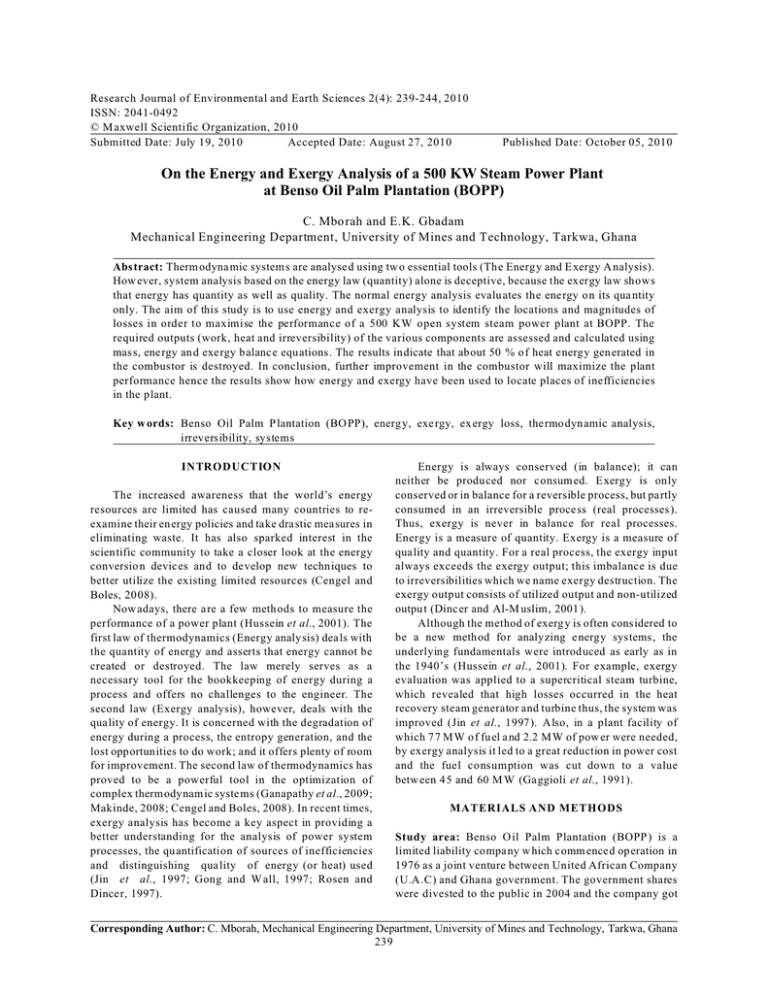
Research Journal of Environmental and Earth Sciences 2(4): 239-244, 2010 ISSN: 2041-0492 © M axwell Scientific Organization, 2010 Submitted Date: July 19, 2010 Accepted Date: August 27, 2010 Published Date: October 05, 2010 On the Energy and Exergy Analysis of a 500 KW Steam Power Plant at Benso Oil Palm Plantation (BOPP) C. Mbo rah and E.K. Gbadam Mechanical Engineering Department, University of Mines and Technology, Tarkwa, Ghana Abstract: Therm odyna mic system s are analysed using tw o essential tools (The Energy and E xergy A nalysis). How ever, system analysis based on the energy law (quantity) alone is deceptive, because the exergy law shows that energy has quantity as well as quality. The normal energy analysis evalu ates the energy on its qua ntity only. The aim of this study is to use energy and exergy analysis to identify the locations and magnitudes of losses in order to maximise the performance of a 500 KW open system steam power plant at BOPP. The required outputs (work, heat and irreversibility) of the various components are assessed and calculated using mass, energy an d exe rgy balance equ ations. The results indicate that about 50 % o f heat energy gen erated in the combustor is destroyed. In conclusion, further improvement in the combustor will maximize the plant performance hence the results show how energy and exergy have been used to locate places of inefficiencies in the plant. Key w ords: Benso Oil Palm P lantation (BO PP), energy, exe rgy, ex ergy loss, thermodynamic analysis, irreversibility, systems INTRODUCTION The increased awareness that the world’s energy resources are limited has caused many countries to reexamine their energy policies and take dra stic measures in eliminating waste. It has also sparked interest in the scientific community to take a closer look at the energy conversio n devices and to develop new techniques to better utilize the existing limited resources (Cengel and Boles, 20 08). Now adays, there are a few methods to measure the performance of a power plant (Hussein et al., 2001). The first law of thermodynamics (Energy analysis) deals with the quantity of energy and asserts that energy cannot be created or destroyed. The law merely serves as a necessary tool for the bookkeeping of energy during a process and offers no challenges to the engineer. The second law (Exergy analysis), however, deals with the quality of energy. It is concerned with the degradation of energy during a process, the entropy generation, and the lost opportunities to do work; and it offers plenty of room for improvement. The second law of thermodynamics has proved to be a powerful tool in the optimization of complex thermodynamic syste ms (Ganapathy et al., 2009; Makinde, 2008; Cengel and Boles, 2008). In recent times, exergy analysis has become a key aspect in providing a better understanding for the analysis of power system processes, the quantification of sources of inefficiencies and distinguishing qua lity of energy (or heat) used (Jin et al., 1997; Gong and W all, 1997; Rosen and Dincer, 1997). Energy is always conserved (in balance); it can neither be produ ced nor consum ed. Exergy is only conserved or in balance for a reversible process, but partly consumed in an irreversible process (real processes). Thus, exergy is never in balance for real processes. Energy is a measure of quantity. Exergy is a measure of quality and quantity. For a real process, the exergy input always exceeds the exergy output; this imbalance is due to irreversibilities which we name exergy destruction. The exergy output consists of utilized output and non-utilized outpu t (Dinc er and Al-M uslim, 2001 ). Although the method of exerg y is often considered to be a new method for analyzing energy systems, the underlying fundamentals were introduced as early as in the 1940’s (Hussein et al., 2001). For example, exergy evaluation was applied to a supercritical steam turbine, which revealed that high losses occurred in the heat recovery steam generator and turbine thus, the system was improved (Jin et al., 1997). Also, in a plant facility of which 77 M W of fuel a nd 2.2 M W of pow er were needed, by exergy analysis it led to a great reduction in power cost and the fuel consumption was cut down to a value betw een 4 5 and 60 M W (Gaggioli et al., 1991). MATERIALS AND METHODS Study area: Benso O il Palm Plantation (BOPP ) is a limited liability compa ny w hich comm ence d operation in 1976 as a joint venture between United African Company (U.A.C) and Ghana government. The government shares were divested to the public in 2004 and the company got Corresponding Author: C. Mborah, Mechanical Engineering Department, University of Mines and Technology, Tarkwa, Ghana 239 Res. J. Environ. Earth Sci., 2(4): 239-244, 2010 Fig. 1: Schematic representation of the cycle with superheat listed on the Ghana Stock Exchange with Unilever Ghana as the majority share holder and having management control. BO PP is o ne of the largest producers of palm oil in Ghana. The plantation is 42 km from Takoradi, which is Ghana’s second port city and capital of the Western Region and it’s also abou t 267 km from A ccra, Ghana’s capital City and about 297 km from Tema the first port city of Ghana. BO PP is also ac cessib le by rail and is next to the Benso Railway Station on the Takoradi to Tarkwa line. Currently, there are 3 ,866 hectares of mature oil palms which were planted between 1978 and 2004. The company has an office in Accra which handles shipping, supplies and other business. As in many organisationa l setups involv ing production, the scheduled working time co ntribute to the productive capacity of the com pany. It is important therefore to ensure that equipmen t usage is ma ximised to save time and money. Ag ain, production managers are demanding strict guaranteed performance to meet production targets. Continuous power supply is nec essary for the achievement of these targets. In Ghana, power supp ly to many consumers has over the years been done by the Electricity Comp any of Ghana (EC G) but this supp ly has always no t been reliable, w ith its many power outag es. Due to the unreliability of power supply from ECG, BOPP manageme nt established a steam pow er plant to supplement power supply from ECG using fibre and shell as the fuel for firing the boiler. The plant produces electrical power by using the energy released from the steam generated in the boiler to drive the turbine blades which in turn drives a generator to generate the needed pow er. The installed plant is to generate power for the processing of oil palm and palm kerne l as well as to supply power for the effluent pond operations and water supp ly installations. The designed power output of the generator is 500 kW (Nadrow ski, 1992) but due to operational inefficien cies an d othe r losses, the daily output is between 350-400 kW. This research therefore seeks to investigate the causes of operational inefficiencies and losses resulting in decrease of expected output of the plant using energy and exergy analysis. The research covers the periods between June 2009 and May 2010. Analysis of plant: The cycle with superheat is used for this analysis. At the plant site, a separate tubing system known as the superheater is placed in the combustion gas cham ber. Fig. 1 shows a schematic representation of the cycle with superheat. Generally, water flows from the feed pump to the steam drum to be heated. The superheated steam enters the turbine and after generating the necessary power it exist the turbine for use in other heating processes or blown into the atmosphere. The water in the boiler drum is heated by the furnace gases to generate saturated steam. The saturated steam then passes from the top of the boiler drum, through the nest of superheated tubes and return to the main stop valve. Superheated steam is drawn off to the turbine where it expands, doing work on the blades of the turbine which drive the electrical generator. After expansion through the turbine, the steam exit still superheated and then used for processes such as fruit sterilization Considering the individual components of the diagram in Fig. 1, the three balance equations are applied to find the work output, the h eat added and the rate of irreversibility. The balance equations are then written as (Dincer and Al-Muslim, 2001; Cengel and Boles, 2008; Ganapathy et al., 2009): 240 Res. J. Environ. Earth Sci., 2(4): 239-244, 2010 The mass balance equation: (1) The energy balance equation: Fig. 2: Energy and exergy balances for feed pump (2) The exergy balance equation: Fig. 3: Energy and exergy balances for combustor (3) where, i : inlet of a component e : exit of a component A : mass flow rate : exergy : work rate in a control volume : heat transfer rate in a control volume To Tj I : su r r ou n d in g t em perature temperature : temperature of system : irreversibility or exery loss and refe re nce Fig. 4: Energy and exergy balances for superheater : heat transfer loss in feed pump Feed pump: The balanced equations for mass, energy and exergy used in finding the energy and exergy losses in the feed pump (Fig. 2) are given in Eq. (4), (5) and (6) (Dincer and AL-Muslim, 2001; Cengel and Boles, 2008; Ganapathy et al., 2009). : exergy loss in feed pump fpi fpe : feed pump inlet : feed pump exit Boiler: The energy losses, (4) (5) exergy losses, equations. (6) where, gfpi : gfpe : h fpi : h fpe : specific specific specific specific , of the boiler com ponents are determined using the energy balance equation and the , are calculated from the exergy balance Com bustor: The mass, energy and exergy balance equations of a combustor (Fig. 3) (Ganapathy et al., 2009) are: exergy at feed pump inlet exergy at feed pu mp e xit entha lpy at feed pu mp in let entha lpy at feed pu mp e xit (7) (8) : work transfer in feed pump 241 Res. J. Environ. Earth Sci., 2(4): 239-244, 2010 (9) where, f : fuel a : air g : gas c : combustor All other parameters have their usual meanings defined above Fig. 5: Component versus energy output Superheater: A diagram of the superheater showing the enegy and exergy balances of the system are shown in Fig. 4. Tab le 1: Im por tant p roce ss da ta for th e pla nt un it Component Tem perature ( o C ) Feed water pump inlet 90 Feed water pump inlet 110 Turbine inlet 300 Turbine outlet 180 Reference or surrounding conditions 32 Flue gas inlet condition 600 Flue gas outlet condition 350 Mass flow rate of steam - 2.5 kg/sec Mass flow rate of fuel (Fiber) - 2.0 kg/sec Mass balance for the gas side: (10) Mass balance for the steam side: Pressure (bar) 0.7 1.4 17 3 1.13 (11) where, Energy balance: : exergy due to heat transfer loss in turbine (12) T : turbine RESULTS AND DISCUSSION Exergy balance: The actual operating data of the components such as, feed water pump temperature and pressure, boiler temperature and p ressure, mass flow rates of fu el and steam and turbine inlet and outlet conditions of the 500 kW steam plant at BOPP were collected for the analysis to calculate the enthalpies and exergies at different state points of the plant. The important process data for the plant unit is summarized in Table 1. Also, the energy and exergy losses of these components have been determined using the equations given in the previous section. From the exergy analys is, it was deduced that the feed water pump ha s no w asted work potential but looking at the boiler section (i.e., combustor and superheater) with a greater amount of heat generated in the chamber some is not available for doing any work. Thus the First law analysis (Energy analysis) as show n in Fig. 5 gave only the quantity of heat generated in the combustion chamber and divert our attention on the improvement of the plant performance. Hence the First law analysis cannot be used to pinpoint prospective areas for improving the plant performance. Moreover, with the Second law analysis (Exergy Analysis) the higher irreversibility in the combustor and (13) where, si : inlet steam so : outlet steam SH : superhearter : exergy due to heat transfer loss in the superhearter Steam turbine: The eq uations of ene rgy and exergy balances are used to calculate the energy losses and exergy destructions in the turbine. The mass, energy and exergy balances for the steam turbine are given in Eq. (14), (15) and (16 ). (14) (15) (16) 242 Res. J. Environ. Earth Sci., 2(4): 239-244, 2010 CONCLUSION An energy and exergy analysis was performed on a steam plant of 500 kW output at BOPP and the energy, exergies and loss opportunity to do work have been determined for the various components considered. The results indicate that about fifty percent (50%) of the total heat energy generated in the combustion chamber is not available for doing any useful work thus havin g its effect on the w ork output o f the turbine. This is due to the irreversibility inherent in the combustion process and the inability to de-ash the chamber at the required time thus preventing smooth circulation of the flue gases on the water tubes. Hence the exergy analysis pinpoints the system where attention has to be paid to maximize the plants performance as have been said by ma ny au thors in the literatures. Fig. 6: Component versus exergy losses ACKNOWLEDGMENT The authors are grateful to Prof. I.A. Adetunde, Dean of Faculty of Engineering, University of Mines and Technology (UMaT), Tarkwa, Ghana for his advice, suggestions and for making this article publishable. The authors would also like to thank Mr. Sebastian Mensah for his contribution towards the com pletion of this work. Our sincere thank s also g o to M r. Am ankrah, M r. Baah and Mr. Imbeah and the engineering section of BOPP for allowing us to conduct the above study by using operating data obtained from the station. Fig. 7: Combined graphs of exergy losses and energy output versus components REFERENCES supe rheater as shown in Fig. 6 is partly due to less heat energy delivered to the superheater tubes. Hence with an increase in the heat energy supply the work output of the turbine will be higher and the irreversibility reduced to the minim al. The energy analysis pinpoints that the amount of energy which is available in the combustor for useful work is higher thus with an imp rovemen t in this section, the plant performance will increase coupled with a maximum work output from the turbine. The combined graphs of the energy and exergy losses are shown in Fig. 7. Also, the smaller the irreversibility asso ciated with a process (i.e., the feed water pump), the greater the power that is produced or the lesser the power consumed; therefore, the performance of a system can be improved by m inimizing the irreversibility asso ciated with it. From the discussions above it is observed that the exergy analysis pinpoints the system where attention has to be paid to maximize the plants performance as have been said by many authors in the literatures. Çengel, Y.A . and A .B. M ichael, 2008. Thermodyn amics: An Engineering Approach. 6th Edn., McGraw Hill Companies, Inc., New York. Dincer, I. and H. Al-Muslim, 2001. Thermodynamic analysis of reheat cycle steam pow er plants. Int. J. Energ. Res., 25: 727-739. Gaggioli, R .A ., A .D . Sama, S. Q ia n a nd Y.M . Al-Sayed, 1991. Integration of a new process into an existing site: A case study in the application of exergy analysis. J. Eng. Gas Turb. Power, 113: 170-180. Ganapathy, T., K. Murugesan, N. Alagumurthi and R.P. Gakkhar, 2009. E xergy analysis of operating lignite fired thermal power plant. J. Eng. Sci. Technol. Rev., 2(1): 123-130. Gong, M. and G . W all, 1997. On exegetics, economics and optimization of technical processes to meet environmental conditions. Proceedings of the T A I E S ’ 9 7 I n t e r n a ti o n a l C o n f e r e n c e o n Thermodynamic Analysis and Improvement on Energy Systems. Beijing, China, June 10-13, pp: 453-460. 243 Res. J. Environ. Earth Sci., 2(4): 239-244, 2010 Hussein, I.B., M .Z.B. Yusoff and M .H. Boosroh, 2001. Exergy analysis of a 120 M W therm al pow er plant. Proceedings of the BSM E-ASM E International Conference on Thermal Engineering. Dhaka, Bangladesh, pp: 177-182. Jin, H., M . Ishida, M. Kobayashi an d M . Nunokawa, 1997. Energy evaluation of two current advanced power plants: S upercritical steam turbine and combined cycle. Trans. ASM E, 119: 250-290. Makinde, O.D ., 2008. Entrop y-generation analysis for variab le-viscosity channe l flow with no n-uniform wall tempe rature. A ppl. Energ., 85: 384-393. Nadrow ski, A., 1992. Manual for CS 5G Boiler and Turb ine. G erma ny, pp : 987. Rosen, M.A. and I. Dincer, 1997. On energy and environmental impact. Int. J. Energ. Res., 21: 643-654. 244
